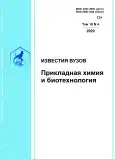Some regularities in the process of anthocyanin extraction from vegetable sources
- Authors: Salasina Y.Y.1, Kalinikin D.S.1, Deineka V.I.1, Deineka L.A.1
-
Affiliations:
- Belgorod National Research University
- Issue: Vol 10, No 4 (2020)
- Pages: 691-699
- Section: Physico-chemical biology
- URL: https://bakhtiniada.ru/2227-2925/article/view/299592
- DOI: https://doi.org/10.21285/2227-2925-2020-10-4-691-699
- ID: 299592
Cite item
Full Text
Abstract
About the authors
Y. Yu. Salasina
Belgorod National Research University
Email: kulchenko@bsu.edu.ru
D. S. Kalinikin
Belgorod National Research University
Email: 1318753@bsu.edu.ru
V. I. Deineka
Belgorod National Research University
Email: deineka@bsu.edu.ru
L. A. Deineka
Belgorod National Research University
Email: deyneka@bsu.edu.ru
References
- Trouillas P., Sancho-Gartfa J.C., De Freitas V., Gierschner J., Otyepka M., Dangles O. Stabilizing and modulating color by copigmentation: Insights from theory and experiment // Chemical reviews. 2016. Vol. 116. P. 4937-4982. https://doi.org/10.1021/acs.chemrev.5b00507
- Dangles O., Fenger J.-A. The chemical reactivity of anthocyanins and its consequences in food science and nutrition // Molecules. 2018. Vol. 23. Issue 8. 1970. 10.3390/molecules23081970' target='_blank'>https://doi: 10.3390/molecules23081970
- Wang H., Cao G., Prior R.L. Oxygen radical absorbing capacity of anthocyanins // Journal of Agricultural and Food Chemistry. 1997. Vol. 45. P. 304-309. https://doi.org/10.1021/jf960421t
- Khoo H.E., Azlan A., Tang S.T., Lim S.M. Anthocyanidins and anthocyanins: colored pigments as food, pharmaceutical ingredients, and the potential health benefits // Food & Nutrition Researh. 2017. Vol. 61. Issue 1. 1361779. https://doi.org/10.1080/16546628.2017.1361779
- He F., Mu L., Yan G.-L., Liang N.-N., Pan Q.-H., Wang J., et al. Biosynthesis of anthocyanins and their regulation in colored grapes // Molecules. 2010. Vol. 15. Issue 12. P. 9057-9091. https://doi.org/10.3390/molecules15129057
- Martm J., Navas M.J., Jimenez-Moreno A.M., Asuero A.G. Anthocyanin pigments: Importance, sample preparation and extraction. In: Soto- Hernandes M., Palma-Tenango M., Gartfa-Mateos R. (eds.) Phenolic Compounds. Natural Sources, Importance and Applications. InTech; 2017. P.117152. https://doi.org/10.5772/66892
- Silva S., Costa M.E., Calhau C., Morais R.M., Pintado M.E. Anthocyanin extraction from plant issues: A review // Critical Reviews in Food Science and Nutrition. 2017. Vol. 57. Issue 14. P. 3072-3083. https://doi.org/10.1080/10408398.2015.1087963
- Ongkowijoyo P., Luna-Vital D.A., de Mejia E.G. Extraction techniques and analysis of anthocyanins from food sources by mass spectrometry: An update // Food Chemistry. 2018. Vol. 250. P. 113126. https://doi.org/10.1016Zj.foodchem.2018.01.055
- Khanh N.D. Advances in the extraction of anthocyanin from vegetables // Journal of Food and Nutrition Sciences. 2015. Vol. 3. Issue 1. P. 126134. https://doi.org/10.11648/j.jfns.s.2015030102.34
- Garcia-Viguera C., Zafrilla P., Tomas-Barberan F.A. The use of acetone as an extraction solvent for anthocyanins from strawberry fruit // Phytochemical Analysis. 1998. Vol. 9. Issue 6. P. 274-277. https://doi.org/10.1002/(SICI)1099-1565(199811/12)9:63.0.CO;2-G
- Zuleta-Correa A., Chinn M.S., Alfaro-Cordoba M., Truong V.-D., Yencho G.C., Bruno-Barcena J.M. Use of unconventional mixed Ace-tone-Butanol-Ethanol solvents for anthocyanin extraction from Purple-Fleshed sweetpotatoes // Food Chemistry. 2020. Vol. 314. 125959. https://doi.org/10.1016/j.foodchem.2019.125959
- Саввин П.Н., Игнатова К.С., Ломакина А.Э. Особенности выделения антоцианов спиртами алифатического ряда // Вестник ВГУ-ИТ. 2015. N 2. C. 171-174.
- Переверткина И.В., Волков А.Д., Болотов В.М. Влияние глицерина на экстрагирование антоциановых красителей из растительного сырья // Химия растительного сырья. 2011. N 2. С. 187-188.
- Переверткина И.В., Волков А.Д., Титова Н.И., Болотов В.М. Оптимизация условий экстрагирования антоциановых красителей из растительного сырья // Химия растительного сырья. 2014. N 2. С. 137-141.
- losub S.D., Meghea A., Geana I. Solvato-chromic parameters of some anthocyanin derivatives concentrated from selective natural extracts // UPB Scientific Bulletin, Series B: Chemistry and Materials Science. 2014. Vol. 76. Issue 1. P. 25-34.
- Lee J., Durst R.W., Wrolstad R.E. Determination of total monomeric anthocyanin pigment content of fuit juices, beverages, natural colorants, and wines by the pH differential method: Collaborative study // Journal of AOAC International. 2005. Vol. 88. Issue 5. P. 1269-1278.
- B^kowska-Barczak A. Acylated anthocyanins as stable, natural food colorants - A review // Polish Journal of Food and Nutrition Sciences. 2005. Vol. 14. Issue 2. P. 107-116.
- Deineka V.I., Deineka L.A., Saenko I.I. Regularities of anthocyanins retention in RP HPLC for “water-acetonitrile-phosphoric acid” mobile phase // Journal of Analytical Methods in Chemistry. 20115. Vol. 2015. Issue 4. Article ID 732918. https://doi.org/10.1155/2015/732918
- He J., Li X., Silva G.T.M., Quina F.H., Aquino A.J.A. Quantum chemical investigation of the intramolecular copigmentation complex of an acylated anthocyanin // Journal of the Brazilian Chemical Society. 2019. Vol. 30. Issue 3. P. 492-498. https://doi.org/10.21577/0103-5053.20180233
- Escribano-Bailon M.T., Santos-Buelga C. Anthocyanin Copigmentation - Evaluation, Mechanisms and Implications for the Colour of Red Wines // Current Organic Chemistry. 2012. Vol.16. Issue 6. P. 715-723. https://doi.org/10.2174/138527212799957977
Supplementary files









